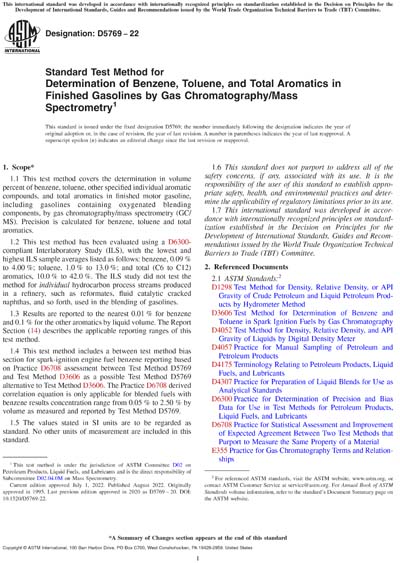Most recent
ASTM D5769-22
Standard Test Method for Determination of Benzene, Toluene, and Total Aromatics in Finished Gasolines by Gas Chromatography/Mass Spectrometry
1.1This test method covers the determination in volume percent of benzene, toluene, other specified individual aromatic compounds, and total aromatics in finished motor gasoline, including gasolines containing oxygenated blending components, by gas chromatography/mass spectrometry (GC/MS). Precision is calculated for benzene, toluene and total aromatics.
1.2This test method has been evaluated using a D6300-compliant Interlaboratory Study (ILS), with the lowest and highest ILS sample averages listed as follows: benzene, 0.09 % to 4.00 %; toluene, 1.0 % to 13.0 %; and total (C6 to C12) aromatics, 10.0 % to 42.0 %. The ILS study did not test the method for individual hydrocarbon process streams produced in a refinery, such as reformates, fluid catalytic cracked naphthas, and so forth, used in the blending of gasolines.
1.3Results are reported to the nearest 0.01 % for benzene and 0.1 % for the other aromatics by liquid volume. The Report Section (14) describes the applicable reporting ranges of this test method.
1.4This test method includes a between test method bias section for spark-ignition engine fuel benzene reporting based on Practice D6708 assessment between Test Method D5769 and Test Method D3606 as a possible Test Method D5769 alternative to Test Method D3606. The Practice D6708 derived correlation equation is only applicable for blended fuels with benzene results concentration range from 0.05 % to 2.50 % by volume as measured and reported by Test Method D5769.
1.5The values stated in SI units are to be regarded as standard. No other units of measurement are included in this standard.
1.6This standard does not purport to address all of the safety concerns, if any, associated with its use. It is the responsibility of the user of this standard to establish appropriate safety, health, and environmental practices and determine the applicability of regulatory limitations prior to its use.
1.7This international standard was developed in accordance with internationally recognized principles on standardization established in the Decision on Principles for the Development of International Standards, Guides and Recommendations issued by the World Trade Organization Technical Barriers to Trade (TBT) Committee.
ASTM International [astm]

